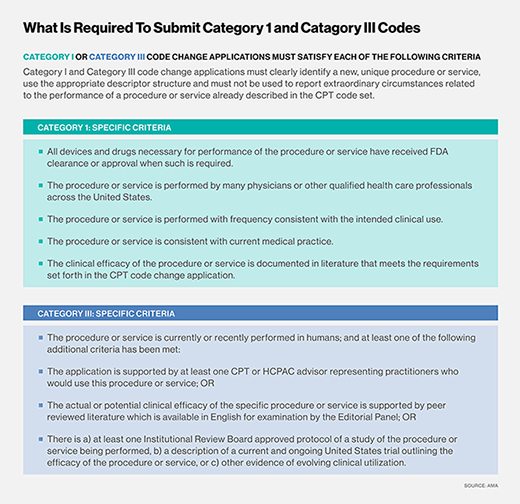What is Current Procedural Terminology (CPT) code?
Current Procedural Terminology (CPT) is a medical code set that enables physicians and other healthcare providers to describe and report the medical, surgical, and diagnostic procedures and services they perform to government and private payers, researchers and other interested parties. CPT codes provide a common language to communicate these procedures and services for various purposes, including administrative management, billing, claims processing, medical care review and medical reporting.
CPT is a registered trademark of the American Medical Association (AMA). Development on the CPT code set started over 50 years ago.
Types of Current Procedural Terminology codes
There are three types of CPT codes: Category I, Category II and Category III. All codes are five digits and can be either numeric or alphanumeric.
Category I CPT codes
The largest body of CPT codes, Category I covers procedures, services and contemporary medical practices that are widely performed. These five-digit numeric codes identify a procedure or service and range from 00100--99499. Many codes are ordered into subcategories based on procedure/service type. A descriptor nomenclature is also included.
Similar codes are clustered in a sequence. However, the sequence may be broken when a new code is added to a family of codes but a sequential number is unavailable, and in the case of evaluation and management (E/M) codes. Category I codes are widely accepted by a range of entities, including third-party payers and the U.S. Food and Drug Administration (FDA). New codes are released annually.
Category I codes are broken down into six sections:
- Evaluation and management.
- Anesthesia.
- Surgery.
- Radiology.
- Pathology and laboratory.
- Medicine.
Category II CPT codes
Category II CPT codes are supplementary tracking codes that are used for performance measurement. These codes are intended to facilitate data collection about patient health outcomes and the quality of care delivered. Using these codes is optional and is not a substitute for Category I codes.
Providers usually assign Category II codes in addition to Category I codes and not instead of. Unlike Category I codes, Category II codes are not linked to reimbursements.
Category II codes are alphanumeric, consisting of four numbers and ending with the letter F. They appear below Category I codes in the CPT codebook and in the following order:
- Composite measures.
- Patient management.
- Patient history
- Physical examination
- Diagnostic/screening processes or results.
- Therapeutic, preventive, or other interventions.
- Follow-up or other outcomes.
- Patient safety.
- Structural measures.
- Non-measure code listing.
New Category II codes are released three times a year.
Category III CPT codes
The Category III CPT are temporary tracking codes that cover the latest technologies, services and procedures. These codes follow Category II codes in the CPT codebook. Unlike Category I codes, Category III codes identify services that might not be widely performed by healthcare professionals, might not have FDA approval, or might not have proven clinical efficacy.
Each Category III code consists of five digits, with four numbers and ending with the letter T. The purpose of these codes is to help researchers track new technologies and services that do not meet the criteria for a Category I code. A service or procedure with a Category III code may be reassigned a Category I code when it receives FDA approval or if evidence is available to prove either that it is performed by many providers, or it has proved effective.
The revised list of Category III codes is released semi-annually on the AMA website.
CPT code list vs. ICD codes
The main difference between CPT codes and International Classification of Diseases (ICD) codes is that CPT codes are related to procedures and ICD codes are related to diagnoses.
CPT codes, or procedural codes, describe what kind of procedure a patient received while ICD codes, or diagnostic codes, describe any diseases, illnesses or injuries a patient might have. Physicians use CPT for billing. In contrast, hospitals used ICD-9-CM for billing, at least until, Sept. 30, 2015. Healthcare providers -- including hospitals and physicians -- also used ICD-9-CM codes to document the reasons for providing a certain service. On Oct. 1, 2015, data submitted to CMS transitioned from ICD-9- CM to ICD-10-CM/PCS.

Code revisions for psychotherapy services
On Jan. 1, 2017, CPT codes related to mental and behavioral health services underwent multiple changes. For instance, the descriptors of several codes were revised to replace the phrase "with patient and/or family member" to "with patient," meaning that a code's stated time for a psychotherapy session would apply only to face-to-face time with a patient. Additional time with the informant is not reported.
Another change was made to the CPT modifier for "synchronous telemedicine." After 2017, the modifier was changed to 95 and it indicates "synchronous telemedicine service rendered via a real-time interactive audio and video telecommunications system."
How CPT codes are formatted and why
CPT codes consist of five characters. These characters could be numeric and alphanumeric depending on which category the code is in. Category I codes are all numeric, while Category II and III codes contain both numeric and alphabetical characters. Unlike ICD, each number or character in a CPT code does not correspond to a particular procedure or technology.
CPT codes are designed to be flexible and allow for revision. These revisions, as well as CPT code set maintenance, are the responsibility of the CPT Editorial Panel that is appointed and authorized by the AMA Board of Trustees. The Panel is also supported by CPT Advisors, groups of physicians who are clinical experts in their respective fields. Regular reviews of CPT codes ensure that clinically valid codes are issued, updated and maintained to provide a widely accepted medical nomenclature used throughout the U.S. for healthcare services.
Changes to CPT codes for 2024
The AMA made several changes to the 2023 CPT code set for 2024. Chief among them were these five:
- Spanish consumer-friendly descriptors were added to assist the Latinx community and build a more inclusive healthcare environment.
- Fifty previous codes were consolidated to streamline immunization reporting for COVID-19. Also, several provisional codes were approved (by the CPT Editorial Panel) to identify Moderna's and Pfizer's monovalent vaccine products for COVID-19 immunization.
- A new vaccine administration code was approved for reporting the administration of any COVID-19 vaccine for any patient.
- Five new CPT codes were created to report product-specific immunization for Respiratory Syncytial Virus (RSV).
- Certain revisions were made to clarify the reporting of E/M services.
Learn how primary care electronic health record (EHR) integration enhances social determinants of health (SDOH) documentation. Explore why medical specialty societies are key to advancing health data standards. See what role EHRs play in clinical informatics and how health information exchanges can support public health and equity.






